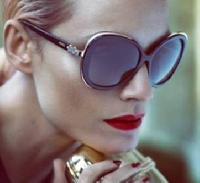
Know how to choose the perfect sunglasses for good looks and eye protection
Knowing how to choose the perfect sunglasses is going to take some thought and time. Of course, you want a pair that flatters your face but even more importantly sunglasses must protect your eyes from harmful ultraviolet (UV) rays.
Dangers
When spending time in bright sunlight, the surface of the eye can be burnt. When this occurs it is called photokeratitis. This is a temporary but painful condition.
If you continue exposing unprotected eyes to sunlight this contributes to the formation of cataracts as well as cancer on the skin around the orbs and on the eyelids. An eye damaged sun develops yellow bumps called pinguecula. The bumps leads to dryness and eye irritation and down the road may mess up the person’s vision.
Outdoor Winter Sports
Those who engage in outdoor winter sports must vigilantly protect their eyes from the glare of the sun. Snow reflects 80 percent of the sun’s rays which is 65 percent more than what is reflected by sand on a beach.
What to Look For
Before buying a pair, read the tags. You are looking for a minimum of 98 percent UVA and UVB protection. For total blocking (100 percent), select quality sunglasses blocking all UV radiation up to 400 nanometers.
Eye doctors recommend wraparound lenses because they cover the sides of the eyes and don’t allow any light in. However, if you do not like this style try wide, close-fitting glasses. Do not wear small lenses. They don’t get the job done.
~
Glasses tinted red, gray, green or amber can offer the same amount of shield as darkly tinted glasses. Gray lenses result in the least amount of color deformation.
Polarized lenses block horizontal light waves that result in glare. However, the polarization itself does not block UV light.
If you are actively participating in sports while wearing your shades, opt for polycarbonate lenses that are durable and won’t shatter.
Ideally, 75 to 90 percent of visible light needs to be blocked. Put on your shades and look in the mirror. If you can see your eyes the lenses are not dark enough. Look for a consistent tint. The lens should not be darker in one area than in another.
Face Shape
Now you know to protect your eyes, first and foremost. Proceed to selecting a pair that is going to work best with your face type. If your face is oval, you’re in luck. It is easy to find shades that look good on you because your face is balanced. You have a narrow forehead and jaw line. The chin is a little narrower than the forehead and the cheekbones are high. Aviators will look particularly flattering on you.
For those with heart-shaped faces, go for cat eye lenses, which look good on a face featuring a wide forehead, high cheekbones, narrow chin and narrower jaw line compared to the forehead.
The square face looks good in round frames. Those with round faces should opt for square frames. If your face is the shape of a diamond, select oval-shaped rimless frames.
Those with an inverted triangle mug should wear frames making the lower part of their face look broader. Rimless eye wear works well as do frames with low temples. On the other hand, if your face is shaped like a triangle, choose frames that make your chin look narrower.
A good rule to remember: Pick eye wear that is shaped the exact opposite of your face. For example, angular glasses look good on round faces and round frames look good on angular faces.
Frame Color
There are numerous frame shades to choose from so which one should you pick? If your complexion is cool, opt for shades in rose brown, demi amber, black, blue-gray, pink, jade or plum. If your skin has warm tones, select camel, fire engine red, copper, camel, gold, peach, warm blue, khaki or blonde tortoise.
